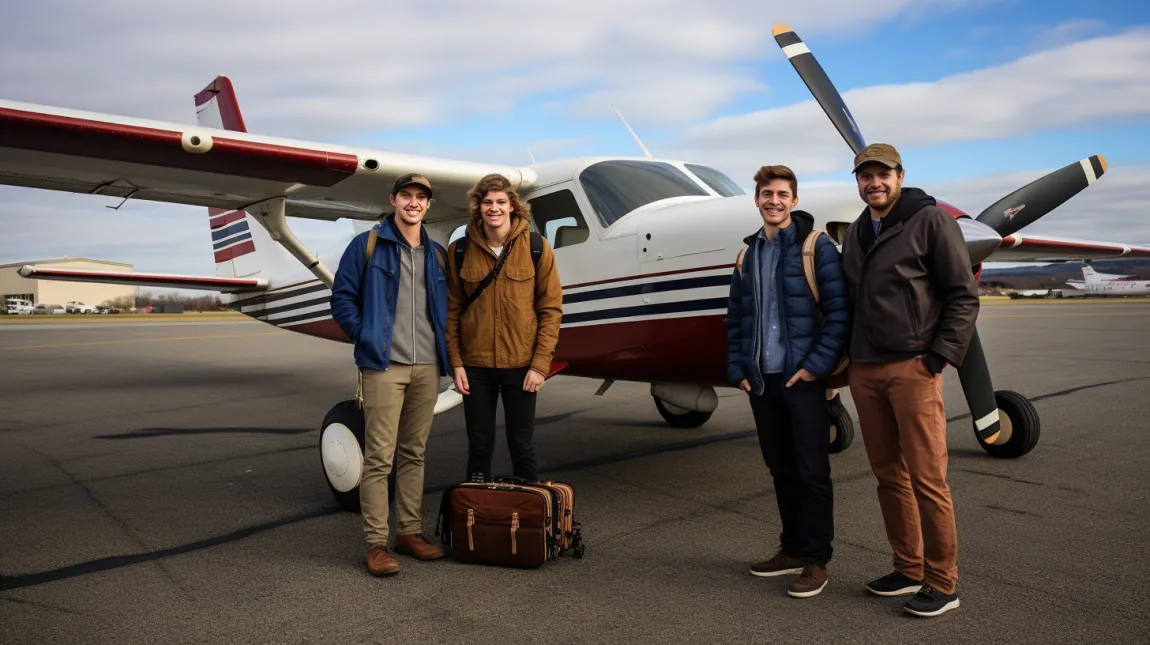Have you ever looked at the sky and wondered what it would be like to fly yourself and your buddies to the next guys weekend without worrying about long lines at the airport or an over zelous TSA agent giving you an intimate massage? Well, it's time to stop wondering and start your journey toward earning a pilot license and getting your own plane. In this article, we'll guide you through the eligibility requirements, medical certifications, training process, and costs associated with private plane ownership.
Key Takeaways
- Benefits of having private pilot privileges
- To obtain a private pilot license, eligibility requirements must be fulfilled, a medical certificate obtained, and training completed.
- Private pilot license requirements include reading, speaking, writing, and understanding English, meeting age requirements, holding a student, sport, or recreational pilot certificate, and passing tests. Private pilot training consists of ground school and flight school, with flight training conducted in three segments.
- Private plane ownership doesn't come cheap
Understanding Private Pilot Privileges
Diving into the particulars of a private pilot license, we can see the unique freedoms and limitations that come with it. As a private pilot, you gain the ability to engage in aviation activities beyond what a typical hobbyist can. You have the authority to operate single-engine aircraft, fly under visual flight rules, and even transport passengers. However, commercial flying for payment or hire is off the table, keeping your activities strictly non-commercial.
The advantages of having a private pilot license are impressive. It grants you unrestricted access to national airspace, the liberty to embark on cross-country flights, and the joy of sharing the experience of flying with others. It's more than just a license; it's an entry pass to a close-knit group of aviation enthusiasts and a world filled with untapped potential.
Costs To Become A Private Pilot And Operate Your Own Plane
Plane ownership isn't the only option, just as with cars and boats - there are a variety of other ways that you can access your aircraft. For instance, while you can buy new from a broker or find used aircraft deals online from an auction site, there are also fractional ownership programs and clubs where you can access planes to use for a specific period. While these services will typically cost more in the long term - they are a great option for new pilots who might be more casual flyers seeking the prestigue of being a private pilot but not wanting to deal with aircraft maintenance and certifications.
Initial Purchase Cost
The cost of purchasing a private plane ranges significantly depending on the size, range, and age of the aircraft. Small, light jets can cost between $2 million and $10 million, while larger, long-range jets may range between $25 million and $75 million. Pre-owned aircraft can be significantly cheaper but still often run into millions of dollars. However, if those prices are out of your budget - don't worry; there are plenty of used single-propeller planes available online for $50,000-$100,000. Many people find this surprising that you can actually get the ultimate freedom of the wild blue yonder for the same price as a fancy sports car!
Operating Costs
Operating costs include fuel, maintenance, repairs, and crew salaries. Light jets range from $500,000 to $1 million per year. For larger jets, the annual operating cost can be several million dollars. These costs fluctuate with usage, fuel prices, and necessary maintenance. Once again, a single-engine aircraft's operating cost will come closer to that of a car - burning about $40-50 worth of aviation fuel per hour. However, maintenance will be significantly more than your car's regular oil change! For example, you should budget $800-$1,500 for the annual maintenance required to keep that single-engine aircraft certified by the FAA, and more complicated propeller planes will cost significantly more. That's not counting damage, or mechanical failures due to older equipment, weather, or pilot error.
Hangar Fees
Hangar fees for aircraft storage can vary widely based on location and amenities. On average, expect to pay between $500 and $3,000 per month to store a small to mid-size jet in a standard hangar and $100-500 for a single-engine plane, or less if you are parking it in a spot outside.
Insurance
Insurance costs depend on the aircraft's value, the pilot's experience, and the region of operation. Generally, insurance can range from $1-5,000 for propeller planes to $500,000+ annually for private jets.
Miscellaneous Costs
Other costs include onboard catering, landing fees, and routine maintenance parts. These can add significantly to the annual operating cost, especially for those who fly frequently or internationally. Like cars, planes lose value over time. A new aircraft can lose up to 30% of its value in the first couple of years. Depreciation must be considered when calculating the total cost of ownership. This is why the market for used propeller planes is so popular. A well-maintained single-engine aircraft will last a long while if treated carefully. While it might not have the fanciest electronics or the latest creature comforts, it is certainly possible to find an older propeller plane that seats four people with space for bags listed at under $100,000 that would make a perfect option to fly you down to Florida for that golf trip!
Buying your aircraft is just the start though. In fact, it's probably the easiest element of this discussion. Now it's time to aquire your private pilot license!
Steps to Acquiring Pilot License
If you're prepared to step into the world of aviation, the initial phase in obtaining a pilot license revolves around meeting the eligibility criteria. This involves being 17 years of age or older, having the ability to read, write, speak, and understand English, and carrying a student, sport, or recreational pilot certificate. Holding a third-class medical certificate is also a necessity.
After you've satisfied the prerequisites for the pilot license, you can begin with the pilot license application process:
- Enroll in a distinguished pilot training program or hire a flight instructor.
- Finish a ground school or home-study course to gain crucial knowledge.
- Pass the private pilot written test and checkride successfully.
Essential Pilot License Requirements
Earning a private pilot license involves complying with a series of stringent requirements laid down by the Federal Aviation Administration (FAA). Appreciating these fundamental prerequisites is the initial move towards realizing your aspiration to fly. The minimum age requirement is 17 years, and you should have a competent command of English, both spoken and written. Another pivotal aspect of your eligibility for a pilot license is a medical certificate. Aspiring to fly isn't sufficient; you also need to be in good health. The FAA mandates at least a third-class medical certificate to ascertain your physical ability to cope with the rigors of flying. Bear in mind, each stride you make leads you nearer to joining the exclusive league of private pilots.
Navigating Pilot License Training
Starting your journey to earn a pilot license is a crucial undertaking. It involves thorough ground school lessons and gaining priceless flight experience under the supervision of an experienced flight instructor. Picking the right flight school is vital for your development. This is more than just a "Drivers Ed" school for the sky, and a good flight school will cover everything from the fundamentals of navigation to understanding the basics of ground operations, such as how to use an aircraft GPU and other equipment to use your aircraft properly. Think about the school's standing, the caliber of instructors, and the types of aircraft available for training.
Your training will entail:
- Grasping theoretical knowledge in ground school
- Accumulating practical experience through flight training
- Effectively managing both
Ground instruction gives you the theoretical framework, while flight training offers the practical experience. Achieving a balance between the two is central to your journey. Rest assured, we're here to support you every step of the way on your way to mastering the skies.
Mastering Pilot License Tests
Establishing a strong theoretical foundation and gaining practical flight experience sets you up for success in your private pilot license tests. Preparing for the written test involves a thorough study and a comprehensive understanding of aviation principles.
For most student pilots, this process will take between six months and a year of time as well as a typical minimum of 40 hours of flight time to become a certified recreational pilot, and additional training will be required for more advanced FAA certifications that you may want to secure. For most of you reading this, the key difference between recreational and private pilot is that as a recreational pilot, you are certified to fly yourself and a limited number of passengers with restrictions. However, you can achieve more advanced pilot training and be a certified private pilot, where you can have more flying privileges as ultimately a commercial pilot or even an air transport pilot if that's something you seek to do.
Relentless practice of multiple-choice questions is key; your goal isn't merely to scrape through, but to stand out. The practical exam is where you validate your flying skills. It's not just about maneuvering the aircraft but also exhibiting sound judgment and decision-making abilities in varied situations. Bear in mind the goal isn't to impress but to prove your ability. Feeling a bit nervous is normal, but trust in your training to see you through. With proper preparation, you'll not only get through these exams but shine in them, moving you one step closer to your dream of flying.
Hey James Hills wants you to share this!

